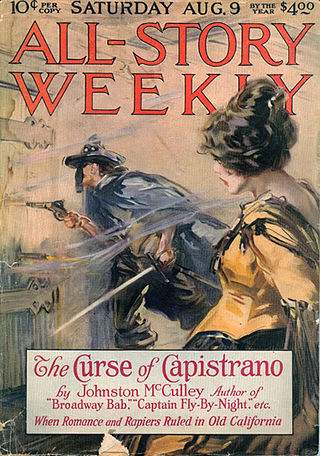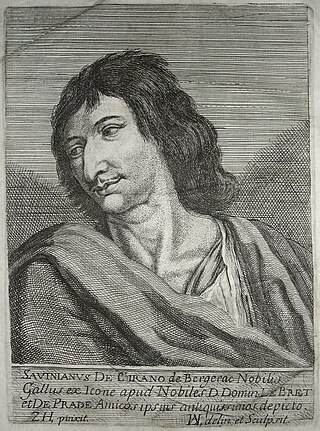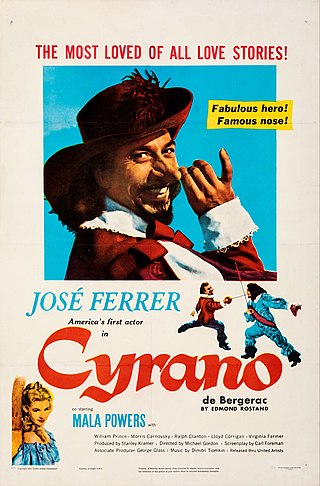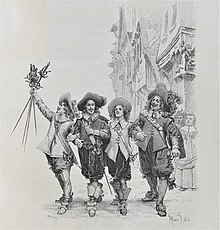
Zorro is a fictional character created in 1919 by American pulp writer Johnston McCulley, appearing in works set in the Pueblo of Los Angeles in Alta California. He is typically portrayed as a dashing masked vigilante that defends the commoners and Indigenous peoples of California against corrupt and tyrannical officials and other villains. His signature all-black costume includes a cape, a hat known as a sombrero cordobés, and a mask covering the upper half of his face.

Stage combat, fight craft or fight choreography is a specialised technique in theatre designed to create the illusion of physical combat without causing harm to the performers. It is employed in live stage plays as well as operatic and ballet productions. With the advent of cinema and television the term has widened to also include the choreography of filmed fighting sequences, as opposed to the earlier live performances on stage. It is closely related to the practice of stunts and is a common field of study for actors. Actors famous for their stage fighting skills frequently have backgrounds in dance, gymnastics or martial arts training.

Sword-and-sandal, also known as peplum, is a subgenre of largely Italian-made historical, mythological, or biblical epics mostly set in the Greco-Roman antiquity or the Middle Ages. These films attempted to emulate the big-budget Hollywood historical epics of the time, such as Samson and Delilah (1949), Quo Vadis (1951), The Robe (1953), The Ten Commandments (1956), Ben-Hur (1959), Spartacus (1960), and Cleopatra (1963). These films dominated the Italian film industry from 1958 to 1965, eventually being replaced in 1965 by spaghetti Western and Eurospy films.

Charles de Batz de Castelmore, also known as d'Artagnan and later Count d'Artagnan, was a French Musketeer who served Louis XIV as captain of the Musketeers of the Guard. He died at the siege of Maastricht in the Franco-Dutch War. A fictionalised account of his life by Gatien de Courtilz de Sandras formed the basis for the d'Artagnan Romances of Alexandre Dumas père, most famously including The Three Musketeers (1844). The heavily fictionalised version of d'Artagnan featured in Dumas' works and their subsequent screen adaptations is now far more widely known than the real historical figure.

An action hero is the protagonist of an action film or other form of entertainment which portrays action, adventure, and often violence. Action heroes are depicted in exciting or perilous chase sequences, fights, shootouts, explosions, and stunt work. Other media in which such heroes appear include swashbuckler films, Western films, old-time radio, adventure novels, dime novels, pulp magazines, and folklore.

An adventure film is a form of adventure fiction, and is a genre of film. Subgenres of adventure films include swashbuckler films, pirate films, and survival films. Adventure films may also be combined with other film genres such as action, comedy, drama, fantasy, science fiction, family, horror, war, or the medium of animation.

The Mark of Zorro is a 1940 American black-and-white swashbuckling film released by 20th Century-Fox, directed by Rouben Mamoulian, produced by Darryl F. Zanuck, and starring Tyrone Power, Linda Darnell, and Basil Rathbone. The supporting cast features Eugene Pallette, Gale Sondergaard, and Robert Lowery. The film is based on the novel The Curse of Capistrano by Johnston McCulley, originally published in 1919 in five serialized installments in All-Story Weekly, which introduced the masked hero Zorro; the story is set in Southern California during the early 19th century. After the enormous success of the silent 1920 film adaptation, the novel was republished under that name by Grosset & Dunlap. The Mark of Zorro was nominated for an Academy Award for Best Original Score. The film was named to the National Film Registry in 2009 by the Library of Congress for being "culturally, historically or aesthetically significant", and to be preserved for all time.

The Mark of Zorro is a 1920 American silent Western romance film starring Douglas Fairbanks and Noah Beery. This genre-defining swashbuckler adventure was the first movie version of The Mark of Zorro. Based on the 1919 story The Curse of Capistrano by Johnston McCulley, which introduced the masked hero, Zorro, the screenplay was adapted by Fairbanks and Eugene Miller.

Cyrano de Bergerac is a play written in 1897 by Edmond Rostand. The play is a fictionalisation following the broad outlines of Cyrano de Bergerac's life.

Cyrano de Bergerac is a 1990 French period comedy-drama film directed by Jean-Paul Rappeneau and based on the 1897 play of the same name by Edmond Rostand, adapted by Jean-Claude Carrière and Rappeneau. It stars Gérard Depardieu, Anne Brochet and Vincent Perez. The film was a co-production between companies in France and Hungary.

Cyrano de Bergerac is a 1950 American adventure comedy film based on the 1897 French Alexandrin verse drama Cyrano de Bergerac by Edmond Rostand. It uses poet Brian Hooker's 1923 English blank verse translation as the basis for its screenplay. The film was the first motion picture version in English of Rostand's play, though there were several earlier adaptations in different languages.

Paul Auguste Jean Nicolas Féval was a French adventure novelist, like his father Paul Féval, père. He was the third of eight children and the eldest son of Paul Féval, who was 42 years old and at the height of his success when Paul Féval fils was born.
Cinematic fight choreography or staged fights in cinema include performances of archery, classical fencing, historical fencing, martial arts, close combat, and duels in general, as well as choreography of full-scale battles with hundreds of combatants.
William Hobbs was a choreographer of stage combat.

Swashbuckler films are a subgenre of the action film genre, characterised by swordfighting and adventurous heroic characters, known as swashbucklers. While morality is typically clear-cut, heroes and villains alike often follow a code of honour. Some swashbuckler films have romantic elements, most frequently a damsel in distress. Both real and fictional historical events often feature prominently in the plot.

On Guard is a 1997 French swashbuckler film directed by Philippe de Broca and starring Daniel Auteuil, Fabrice Luchini, Vincent Perez, and Marie Gillain. Adapted from the 1858 historical novel Le Bossu by Paul Féval, the film is about a skilled swordsman named Lagardère who is befriended by the Duke of Nevers. When the duke is attacked by his evil cousin Gonzague, the duke in his dying moments asks Lagardère to avenge him and look after his infant daughter.
Passport to Adventure, later retitled Passport, was a Canadian movie television series which aired on CBC Television from 1965 to 1967.

Revenge of the Musketeers is a 1994 French swashbuckler adventure film directed by Bertrand Tavernier and starring Sophie Marceau, Philippe Noiret, Claude Rich, and Sami Frey. Set in the seventeenth century, the film is about the daughter of the renowned swordsman D'Artagnan who keeps the spirit of the Musketeers alive by bringing together the aging members of the legendary band to oppose a plot to overthrow the King and seize power. Revenge of the Musketeers was filmed on location at the Château de Biron in Biron, Dordogne and the Château de Maisons in Maisons-Laffitte in France and in Portugal with a budget of $9.1 million.

Cyrano and d'Artagnan is a 1964 French adventure film directed by Abel Gance, starring José Ferrer and Jean-Pierre Cassel. It is set in 1642 and tells the story of how the poet and duelist Cyrano de Bergerac teams up with the musketeer d'Artagnan in order to stop a plot against king Louis XIII. The film draws from Edmond Rostand's 1897 play Cyrano de Bergerac and Alexandre Dumas' three-volume novel d'Artagnan Romances. Ferrer repeated his role from the 1950 film Cyrano de Bergerac. Cyrano and d'Artagnan had 651,213 admissions in France.
Nazzareno Zamperla was an Italian actor and stuntman.



















